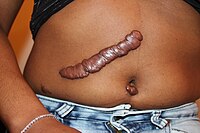Keloid Formation

Description
Keloid is a dermal fibroproliferative growth caused by pathologic wound healing following skin injury. Keloid is defined as a scar growing continuously and invasively beyond the confines of the original wound and is characterized by excessive fibroblast proliferation and deposition of extracellular matrix and collagen fibers. Local tissue factors, especially wound tension or infection, and endocrine factors are known to be involved in keloid formation. However, the fact that the incidence of keloid is higher in darker-skinned individuals suggests that genetic factors also play an important role (summary by Nakashima et al., 2010).
Clinical FeaturesOvergrowth of connective tissue of the skin occurs after trauma. Bloom (1956) described cases in 5 generations. Bohrod (1937) speculated that sexual selection favored the genotype of keloid formation. He presented evidence that cicatrization was practiced as a pubertal rite by Africans and that 'good' scar formers may have been on the average more fertile. Cosman et al. (1961) found a familial incidence of 3%. McKusick (1972) reported a transverse keloid over the upper sternum in father and son who recalled no trauma preceding the development of the keloid.
Peltonen et al. (1991) applied molecular genetic techniques to the analysis of keloids. They concluded that the initial step in the development of fibrotic reaction in keloids involves the expression of the TGFB1 gene (190180) by the neovascular endothelial cells, thus activating the adjacent fibroblasts to express markedly elevated levels of the gene product, as well as the products of the type I (120150, 120160) and type VI (120220, 120240, 120250) collagen genes.
Marneros et al. (2001) studied the clinical and genetic characteristics of 14 pedigrees with familial keloids. The ethnicity of these families was mostly African American but included Caucasian, Japanese, and African Caribbean. Pedigrees accounted for 341 family members, of whom 96 displayed keloids. A female predominance was seen. Syndromes associated with keloids, namely Rubinstein-Taybi (180849) and Goeminne (314300) syndromes, were not found in these families. Additionally, linkage to the gene loci of these syndromes and X-chromosomal linkage were excluded. The pattern of inheritance observed in these families was consistent with an autosomal dominant mode with incomplete clinical penetrance and variable expression.
MappingAssociations Pending Confirmation
Nakashima et al. (2010) performed a multistage genomewide association study in 824 Japanese individuals with keloid and 3,205 Japanese controls and identified significant associations of keloid with 4 SNPs in 3 chromosomal regions. The most significant association with keloid was observed at rs873549 on chromosome 1q41 (combined p = 5.89 x 10(-23); odds ratio, 1.77). Associations on chromosome 3q22.3-q23 were observed at 2 separate linkage disequilibrium (LD) blocks, with rs1511412 in an LD block including the FOXL2 gene (605597) (p = 2.31 x 10(-13); OR, 1.87), and with rs940187 in another LD block (p = 1.80 x 10(-13); OR, 1.98). In addition, association with keloid was found with rs8032158 in the NEDD4 gene (602278) on chromosome 15q21.3 (p = 5.96 x 10(-13); OR, 1.51).